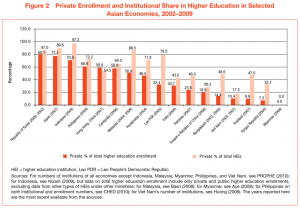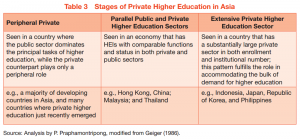Hi class,
As this class comes closer to the end, I feel like delving into another important factor of HE across Asian countries – the role of private institutions.
For comparison, I attached data from Asian Development Bank (https://www.adb.org/sites/
Moreover, it presents a kind of typology classifying each country in Asia into 3 categories (see below).
To me it seems that each country’s situation reflects not only on their economic situation but also on social and political contexts and government policies related to HE.
Here are questions for discussion;
1. How do you relate each country’s situation to government policies that we covered or not in the class?
2. This data is in late 2000s – do you see drastic changes to this trend nowadays and if so, what’s the driver?
Thanks for reading!
Hiro


Thanks, Hiro ! I think these data are essential to see after a whole semester’s discussion on HE in Asia. I think it is interesting to see the balance between public and private sector with the relationship with economic development. Peripheral private is always correlated with developing country and Extensive private sectors are correlated with high economic developed country. I wish to explore whether there is an causality relationship between strong private HE sector and economic development. Does private HE dominance determines more industrial experience within the college? China, now, the first tier of HE are public owned. Does the private institution also has a change to win in the near future??
Thanks for your sharing, Hiro.
It is not surprising that China is not on the top of the list. China’s higher education used to be dominated by public universities because of historical and political reasons. But as the article states, China is now moving toward parallel public and private higher education sectors. It has been catching up fast in less than a decade, with the private higher education enrollment share near 20% and the institutional share almost 30%. The reason is very simple – China has a huge market because of the population. The trend is in response to soaring demand for higher education and the ability of the country is limited.
However, in China, private schools are often the second choice of students who score poorly on the national entrance exam. Because private institutions are expensive and in the mind of the general public, the quality is not good. Moreover, whether a degree from a private college is workable on the job market remains unclear. So the key issue is how to raise the quality and reputation of Chinese private universities. In 2003, the government permitted private schools to partner with public universities. It gives some prestige through the associations while also helping public universities deal with overflow. But still, the private institutions need to find their distinctions to attract outstanding students in China.